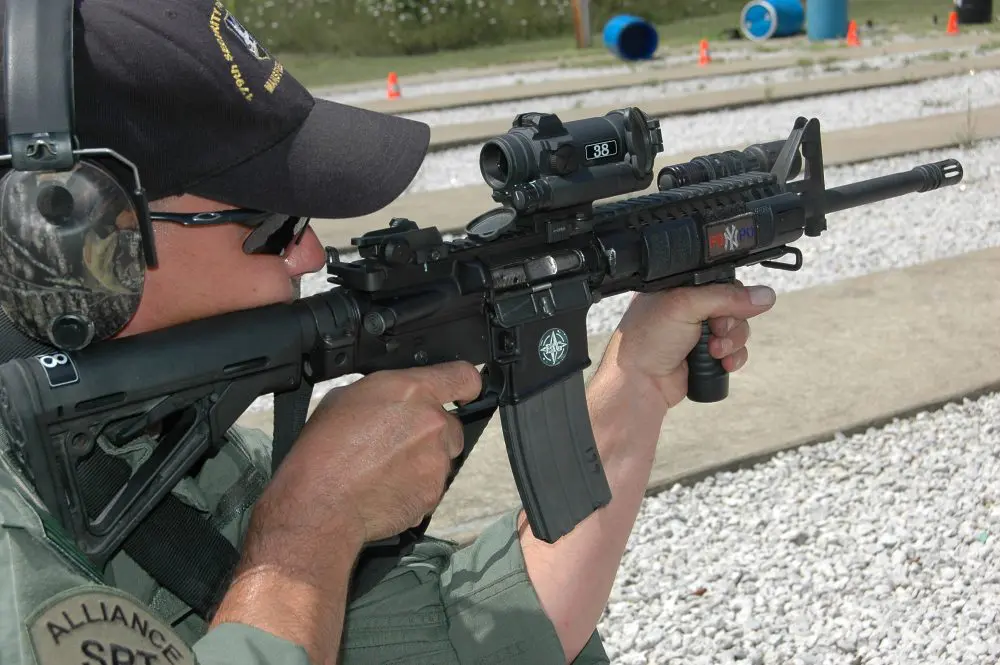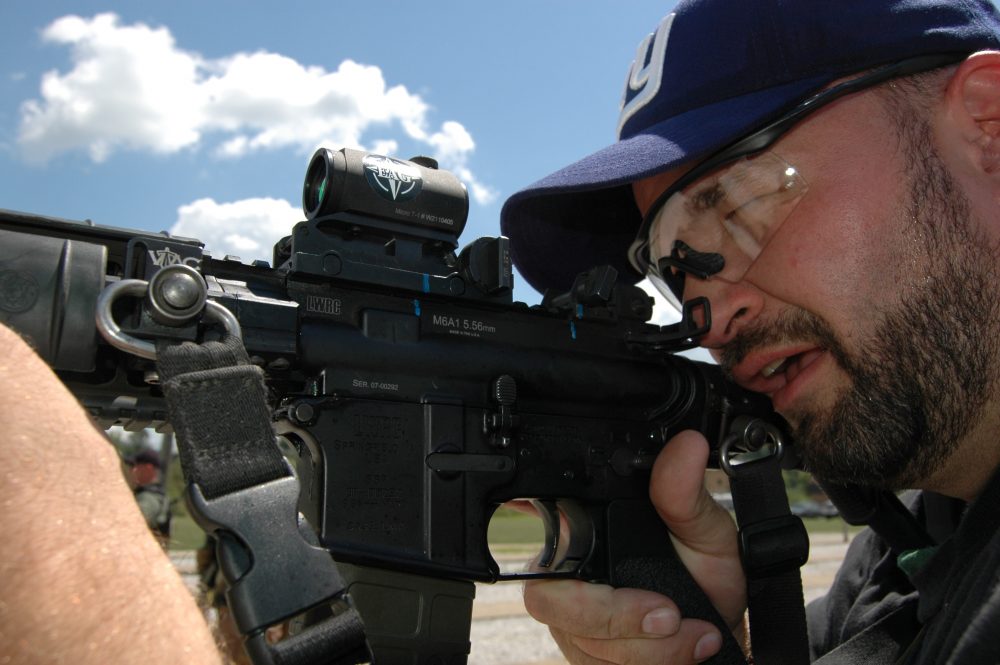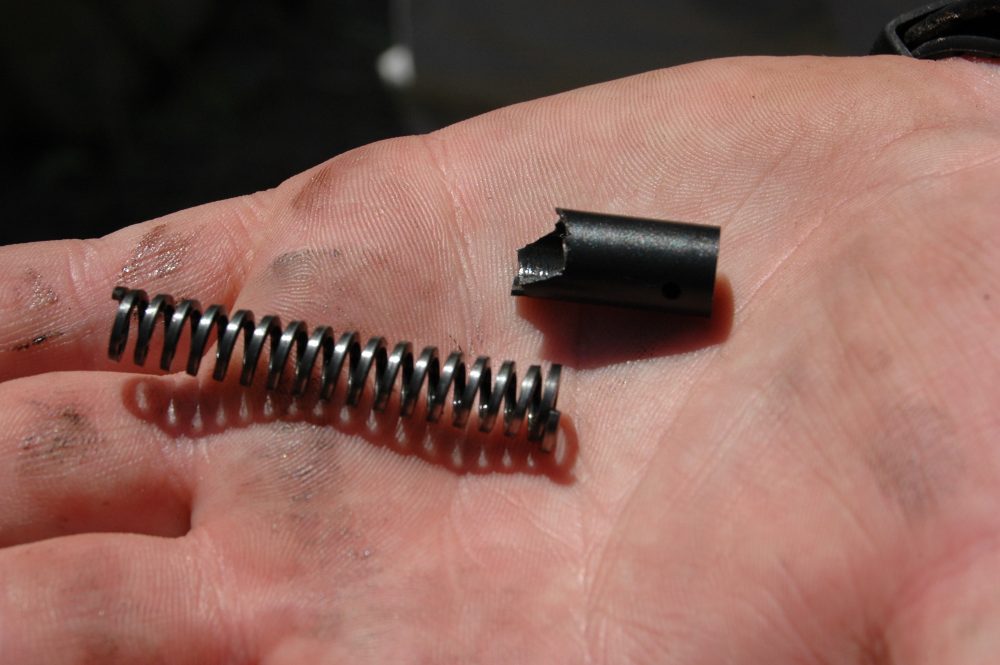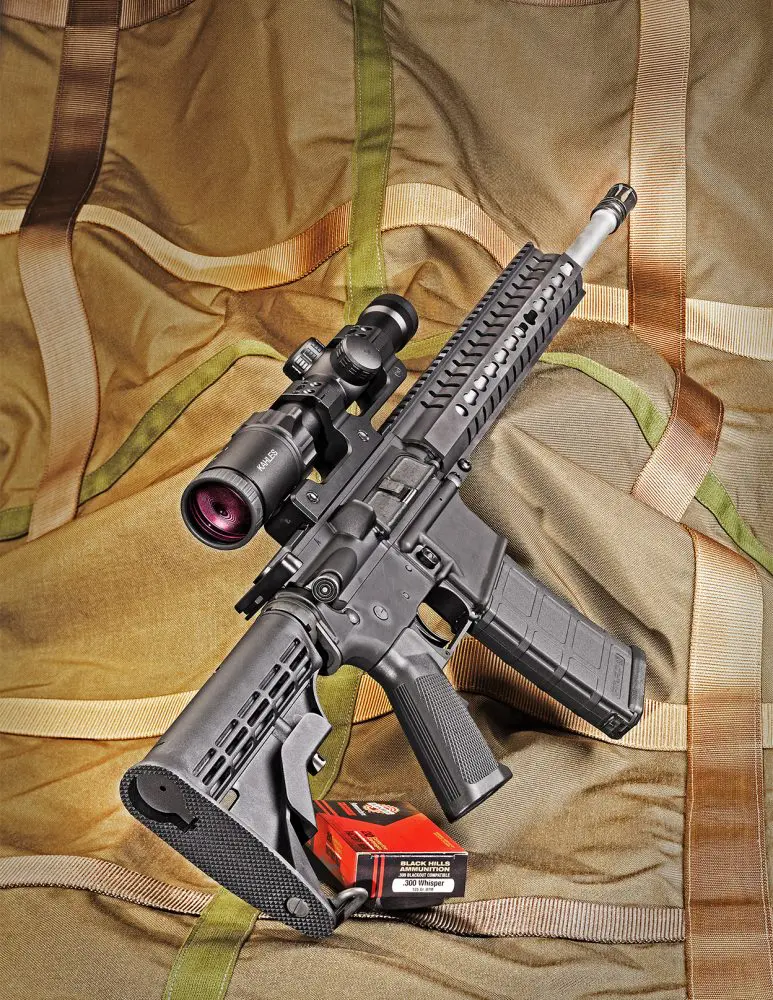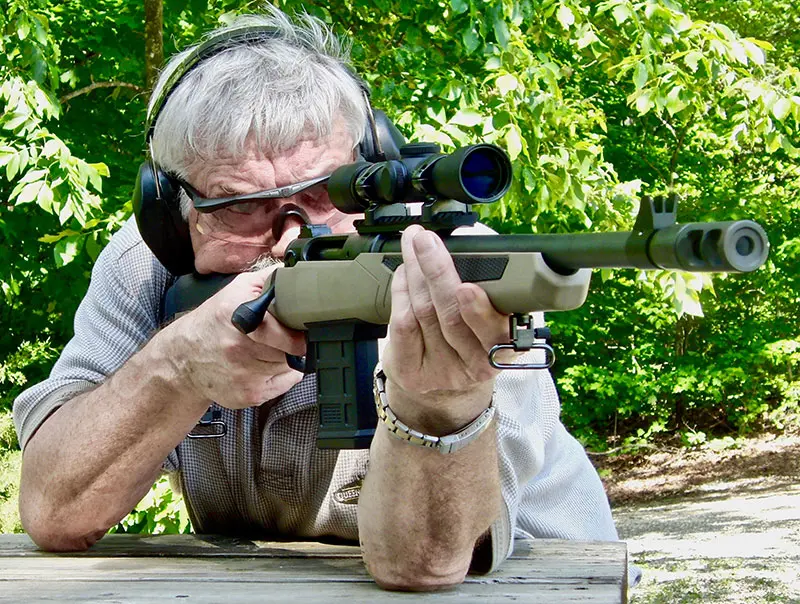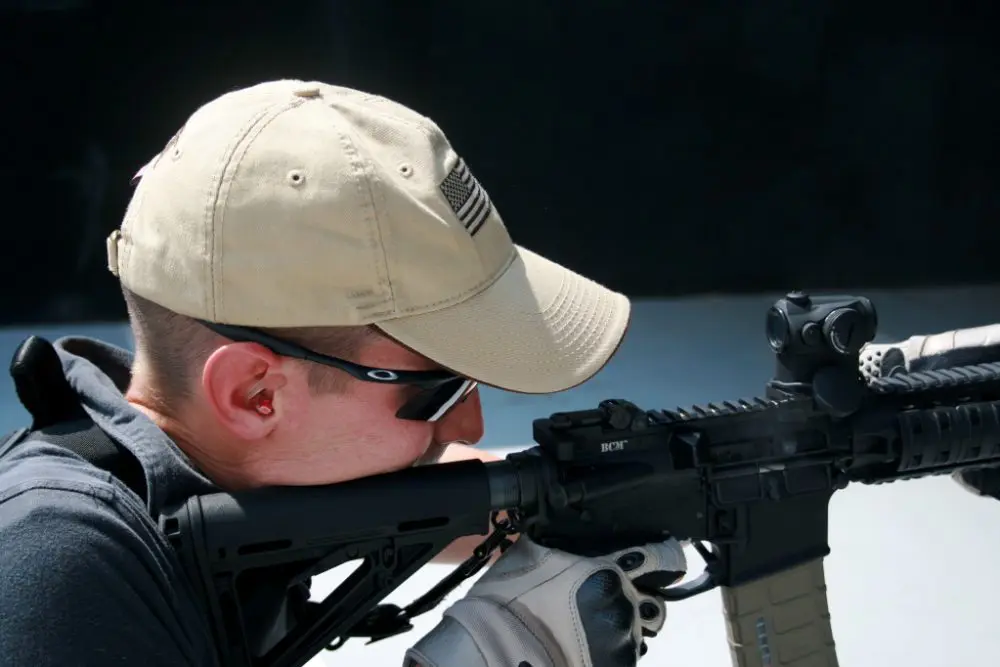Piston-type M16s are not new, but they are being looked at differently now than in the past. That the system offers advantages is without question, though the extent and relevance are debatable.
At EAG Tactical, we’ve seen some piston guns come through class in the past two or three years—primarily H&K 416s on the mil side and a few from various makers on the civilian side. Some of those guns ran well and some didn’t, but we never saw enough of any one maker for long enough to get any warm and fuzzy feelings about them. However, within the past 18 months we have been seeing a lot more.
Mike Jones, Alliance, Ohio SWAT cop with #38. Mike and his guys were solid shooters, and his facility likewise great. #38 has CTR stock, Aimpoint T1 M4s in LaRue Tactical Mount, LaRue FUG, Viking Tactics Sling and Light Mount.
At the Modern Day Marine Show in August 2007, Darren Mellors and Jesse Gomez of (then) LWRC invited me over to see their wares. Within the booth were a number of items that intrigued me, but the reputation of the first owner of LWRC was a major obstacle in the highway for me. It took almost four months before I was satisfied that the takeover executed in July 2006 by Darren, Jesse and the others was successful and that the quality of the guns being produced was sufficient for an evaluation.
The patented short-stroke piston system is supposed to prevent the hot gasses caused by firing from being blown back into the receiver and bolt carrier group. This results in less heat for those components, which would translate into longer life and less cleaning. Additionally, the LWRCI system is externally similar to a legacy AR, so there is no distinction to observers.
The differences between direct impingement and the short-stroke gas piston have been well explained elsewhere. If you are interested in learning more about the LWRCI patented short-stroke piston system, go to their website at www.lwrci.com. My interest here is less from an engineering standpoint and more from a shooting point of view.
“Toxic” Matt Renz with #39. We replaced the Aimpoint M4s with an Aimpoint T1 in a prototype Matech M249 Mount. Matt’s unique ability to make functional items nonfunctional provided the manufacturer with solid information.
I received three LWRCI M6A1 carbines for long-term evaluation (actually two complete LWRCI guns and one upper on another maker’s lower). We chose the M6A1 because we wanted the fixed front sight base for doctrinal reasons. We prefer the front sight up all the time, so that in the event of optic failure we can immediately re-engage while using the optic as a rear sight (think large ghost ring). Other variants exist, including M6A2, A3, A4, PSD and the 7.62x51mm SABR.
We ran these guns hard for ten months, putting approximately 60,900 cumulative rounds downrange through the three guns. Almost all of the ammunition was expended during classes, where the firing schedule is harsh—we wanted to run the guns hard and see what they could do.
The term “rode hard and put away wet” is applicable here. These guns received minimal cleaning, as we wanted to see exactly how much cleaner they were than a direct impingement gun. We also performed minimal maintenance on the guns. While I normally change some parts out at intervals—extractors and such—we generally let the LWRCI guns run until we saw functioning issues. The purpose of the exercise was to see how they ran under less than ideal conditions/circumstances.
M6A1 Trio. #38 and #39 are configured similarly, with the exception of #39’s M4S mount. This is an Aimpoint prototype, and at the request of Freddie Blish we gave it a shot. The only negative is that a tensioning screw kept backing out, meaning that like all screws on the gun, Loctite is necessary. #24 has a MagPul UBR stock vice the MagPul CTR on the other, and a T1 in a Larue Mount. I put a lot of rounds downrange in #24, and found this carbine to be among the most reliable I have ever used. The combination of the UBR stock and the T1 optic makes it a very fast handling gun.
A caveat is necessary. The attempt here was to get as close to real world testing of the guns as possible. We did not test the guns in an airless, stress-free laboratory utilizing the latest, most sophisticated equipment. We used old-fashioned sweat and hard work instead.
Neither did we do any accuracy testing. The variables involved make it time consuming and without any discernible benefit.
Our students volunteered to shoot the carbines at class, using their ammunition and (in some cases) their magazines. If they had insufficient magazines, we provided PMAGs for the duration of the class.
The students did not clean the guns. My able Assistant Instructor, Mike Hueser, took care of that at infrequent intervals. We kept them wet with our standard lube—Slip 2000 Extreme Weapons Lube.
Remember that what you see here is our experience with three guns—a small statistical sample—but over a relatively long time.
Brian Cashin Sr. solves a problem in the Memphis, TN Police Department shoot house. Here he follows a threat (a reactive target) down to the deck. His finger is straight and he is prepared to engage additional threats. #24 has an Aimpoint T1 in a Larue Mount, a MagPul UBR stock, TangoDown pistol grip, VFG and rail panels and a Viking Tactics Sling and Light Mount.
Please note that at the beginning of this evaluation, LWRC was in its second life, employees having executed a coup d’état that resulted in the excommunication of the former owner. The company was experiencing a great deal of turbulence, but moving forward—though not as quickly as anyone wanted.
The result of this turbulence was an increase in the number of guns produced, but without the parts inventory that would ensure consistency. Increasing the parts inventory and enhancing quality control were priorities.
This occurred in April 2008, when the company was bought by Dick Bernstein (owner of Matech), which brought significant changes at many levels. The company moved from Springfield, Virginia to Cambridge, Maryland, and LWRC became LWRC International. The move gave LWRCI access to Matech’s impressive manufacturing capabilities, but also its Quality Control/Quality Assurance expertise, and LWRCI is now ISO 9001 compliant.
Additionally, LWRCI now has access to a large inventory of in-spec parts, and is in the process of manufacturing in-house a large percentage of the parts that comprise their guns.
This is a terrific step forward as LWRCI—not its vendors—can control inventory and quality.
What follows are our observations only. Your mileage may, of course, vary.
New bolt is NiCorr-coated and has boss at end to prevent tilting. Gas key is dovetailed into carrier, and gas keys are now staked. Had this upgrade been available earlier, it would have prevented two of our problems.
Table of Contents
RACK #24
Rack #24 was the first LWRC carbine we received, in December 2007. This was an M6A1 upper only, with a stainless steel, 1:7 twist barrel and an LWRC rail. This was not the barrel that we would have chosen, preferring instead a chrome-lined barrel. However, this was all that was available at the time.
We put this upper on a Magpul MPLA Lower, with a UBR stock, TangoDown PR-4 sling mount, a Viking Tactics LUSA, Viking Tactics Sling and Light Mount with a SureFire G2 light/Tactical Night Vision Company (TNVC) Cree Q5 Lamp and Z 59 switch.
We used the TangoDown pistol grip, Vertical Foregrip and rail panels.
The package was topped off with an Aimpoint T1 Micro on a LaRue LT 660 mount, and a Matech BUIS.
Op rod spring in #38 failed, flattening out on one end and cracking the spring cup. This happened after approximately 4,000 rounds on this spring.
RACK #38
Rack #38 came to us in February 2008. This was a complete LWRC M6A1 with a chrome moly, 1:7 twist barrel. This carbine was equipped with a UBR stock, TangoDown pistol grip, Vertical Foregrip, PR-4 sling mount, rail panels, a Viking Tactics LUSA, Viking Tactics Sling and Light Mount with a SureFire G2 light/TNVC Cree Q5 Lamp and Z 59 switch.
This carbine had an Aimpoint T1 M4s on a LaRue LT 659 mount, and a Matech BUIS.
RACK #39
Rack #39 is a nearly identical twin to #38, with the exception of an Aimpoint M4s in a prototype Aimpoint mount and a LaRue FUG.
During the first class in February in North Carolina, all three guns ran like the proverbial clock. At the second class in March at Brady, Texas, both #38 and #39 started burping, and #38 started double feeding. We swapped magazines, but the problem continued.
There were multiple feeding issues with #39. We looked at ammunition, checked the bolt and operating system, but they continued. Both shooters were very experienced, and they stuck it out through the class.
Two hard-shooting soldiers run #39 and #38 at Green Valley Club in Columbus, Missouri. We received a lot of good feedback from these professionals.
We were unable to rectify either issue in the Great State of Texas, but on arrival at Casa Grande, Arizona, Mike Hueser wound up cleaning both #38 and #39 in the bathtub of a lousy motel. While doing that, we replaced the extractors, extractor springs and inserts and action springs on both #38 and #39. When we have to work on a student’s gun at class, we normally do this and figured it wouldn’t hurt.
Meanwhile, #24 continued to run like a sewing machine and so did #38. On Day 1 at approximately 2,700 rounds, #39 stopped running, with the gun locking up. When we took the gun apart, we found that the forward gas key screw had cracked and the upper part of the screw had fallen into the lower receiver.
We couldn’t remove the lower part of the screw, so we cleaned the parts, applied Mr. Loctite and put the gun back in service. It ran with no further problems.
LWRCI M6A1 next to a Direct Impingement M4 type carbine. This M6A1 had not been cleaned in over ten thousand (10,000) rounds, while the M4 type is brand new. Piston guns do get dirty, but under the handguards and not in the lower receiver. This has less negative effect on operation of the gun.
We brought the guns back to the factory at the end of this trip. Upon inspection, Jesse found that the barrel/rail on #38 was loose. That was squared away and a new bolt carrier group (BCG) put into #39. There were approximately 3,600 rounds downrange at this time.
At the Camp Ares class in Florida, a very good shooter who was also apparently toxic to guns wound up with a rock in the lower receiver of #39. How this happened is beyond me, but he was unable to shoot anything other than barn-sized groups. We played musical guns and gave him #38 to finish.
We shot #39 after this class with M855 and commercial 55-grain ball, and accuracy was back to within specs. We can’t explain why this anomaly occurred, but the vagaries of ammunition type, manufacturing standards and voodoo can lead to a tolerance stack that baffles me.
In May, all three guns ran fine in Wisconsin.
We traveled to Pueblo West in Colorado, and while there—at approximately 5,400 rounds—#39 stopped running. Jeff Carpenter took a look at it and discovered the op rod spring was cracked in half, and the op rod missing. We did a walk-through on the range and a student found it. We replaced the spring and op rod and all was well.
Shooter rips off a hammer in Oklahoma. He moved his light from ten o’clock to five o’clock—an easy move with the VTAC mount.
We had no issues with any of the guns at Durango, Colorado.
In the beginning of July, Jesse Gomez asked us to bring #24 in. They had a supply of Cold Hammer Forged Barrels and wanted to change the upper to reflect the current standard. We had 9,170 rounds through this barrel, and that is about the service life of hard use stainless steel barrels, so I was up for the change.
The new barrel was a 1:9 cold hammer-forged model made of 41V45 steel. This barrel is not chrome lined, but has a NiCorr™ finish, which is a surface conversion, not a plating. This finish is harder wearing, more lubricious and more heat- and corrosion-resistant. Cold hammer forging uses an oversized barrel blank over a highly polished mandrel. High-pressure rotary hammers compact the molecular structure of the barrel and make it denser and stronger.
In August in Ohio, #38 stopped running due to a popped primer—an ammo issue and no fault of the gun. We gave the shooter #39, which quickly started burping. Matt Renz was convinced that he was jinxed, but we replaced the action spring, which had over 9,000 rounds on it (it was past due), and the gun ran after the spring was replaced.
Oklahoma State Trooper runs #24 dry during a drill. These guys from Oklahoma and Texas can flat shoot. This trooper’s working gun was an A1 with a Reflex sight on a cantilever mount. He and a Trooper in another relay took turns swapping this gun and getting a real high round count for the class.
In Pennsylvania, at approximately 13,600 rounds, #39 started to experience multiple double feeds. Two live rounds trying to get into the chamber at the same time is almost always a magazine issue. We were using proven PMAGs, so while it was possible, neither was it probable. Mike took a good look at the gun during a string of fire, and it became (belatedly) clear what was going on. The ejection port cover spring had failed, and the door was flopping around. It would sometimes hit an ejecting case and knock it back in, causing a Type 3 malfunction. This is not exactly unheard of, but neither is it rare.
Shortly after this, I went to do a factory visit at the new LWRCI in Cambridge, Maryland. While there, Jesse Gomez asked if I wanted to replace the uppers on numbers 38 and 39, which had 13,665 and 13,651 rounds downrange respectively. The existing barrels were still within specs, but Jesse wanted to get some rounds downrange on the new cold hammer-forged barrels, which are now standard with all LWRCI guns. The exchange was made, and the guns placed back in the rotation.
There were no issues noted in Memphis in September.
At the next class in Oklahoma, #38 had several failures to eject, but the shooter finished the course with it.
In North Carolina, #39 had several Type 2 Malfunctions.
In October at Camp Ares in Florida, we found that once more the op rod spring had failed (this time in #38), this time flattening out and breaking the spring cup. The parts were replaced and it ran with no problems.
A shooter’s gun went down and #24 was loaned out to him, and the M855 he was using would group about ten MOA out of the 1:9 barrel. It continued to shoot within three MOA with 55-grain, but clearly didn’t like anything heavier. I don’t have much use for 1:9 barrels anyway, but having M855 open up this much was unusual, and just confirms my preference for a 1:7 barrel on a working gun.
Gas and carbon have to go someplace, and with the short stroke piston, they go here. There is over 10,000 rounds worth of crud here, where it only looks bad. Those who are obsessive/compulsive, upon seeing this, will likely have their eyes roll back and start speaking in tongues. However, our purpose was not in having pristine weapons that would sit in a safe for all to admire, but rather see how these guns would function under the harsh conditions that professionals might encounter downrange.
At the October Arizona class, #38 locked up. We found the front gas key screw had cracked and fallen into the lower receiver. At about the same time, #39 started firing on reset. That lower had approximately 17,000 rounds through it, so it should be considered a normal wear item (I generally replace the lower parts components at 10,000-12,000 rounds).
We replaced the BCG on #38 and the lower parts kit (LPK) on #39 and they completed the course (and a tip of the hat to Scott Loomis!).
Later in October in Missouri, #24 started hiccupping to the point where we had to pull it off the line. This was extremely frustrating, as this gun had run so well for 19,000 rounds before we experienced any problems at all.
We brought #24 back to the factory, where Jesse waved his hands over it, cleaned it and replaced the BCG with a new one (see below for a description of that BCG).
In December in Florida, we used only #39 and #24—both ran without issues.
The round count at the end of this evaluation looked like this:
#24: 20,270 rounds
#38: 21,615 rounds
#39: 19,015 rounds
At the end, there were two recurring issues—the op rod springs and broken gas key screws.
A quick fix is to replace the op rod springs at 5,000-round intervals. However, the long term (and correct) fix is a new spring type. This is being accomplished as this is written, and an engineering change may also take place.
This bolt came out of this upper. It has been faithfully lubed with Slip 2000 EWL, and wiped down twice during in this cycle.
The gas key screw breakage was the result of a vendor substituting parts that were of lesser quality than what was ordered. To that end, new screws are in the pipeline, and they will now be staked.
In the beginning, we saw what we believed were metal shavings in one of the upper receivers. However, it turned out to be flaking of the chrome plating from a bolt carrier.
As an interim upgrade, a new bolt carrier was introduced. This has the NiCorr™ corrosion finish, but the gas key will have a downward slope and the bolt carrier a large boss around the tail to prevent off-axis movement.
Sometime in 2009, a one-piece bolt carrier will come online, eliminating the need for a separate gas key and screws. Note that a standard M16 BCG will not work in this system.
Earlier, I stated this was not a traditional test. To accomplish that, we would need a lot more consistency, especially with ammunition. We relied on the students who attended our classes to supply the ammunition they would have fired out of their carbines.
Considering the price and availability of ammunition, as well as the fact that most shooting in these classes occurs at less than 50 yards, premium ammunition was not often fired in these guns.
Different shooters at different locations and in different environmental conditions can experience different results.
We ran the guns hard, seldom cleaning them but keeping them well lubed. Wear will occur when a gun is used. Some items, such as extractors and springs, will wear at a faster rate than others, while barrels will slowly lose accuracy over a longer time frame. That is normal. The more you shoot, the more wear/breakage you will see.
Does the short-stroke system run cleaner? There is no doubt that it does. The guns run much cleaner, but still require cleaning and lubrication, though the intervals are longer than with a direct impingement gun. There is no such thing as a maintenance-free gun.
After we fired the last rounds of this evaluation at the December 2008 class at Southern Exposure Training Center, we felt that we had only partially accomplished our goal. We were able to identify some issues that needed changing—the recoil springs and BCGs, for example—but would have liked to have had the opportunity to run the cold hammer-forged barrels longer, as well as the one-piece BCGs and other upgrades. What comes out of the LWRCI factory in 2009 will likely be a different gun than what came out in 2007.
Throughout the testing period, the staff at LWRC (and later LWRCI) were helpful in the extreme. They responded to every request, telephonically or by electrons, and kept us informed as to engineering updates. They were unfazed by my relating component failures and other issues, as they felt that it gave them opportunities to improve the product.
The LWRC of three years ago is not the same as the LWRCI of a year ago. They are part of a larger company with three modern factories that has a culture of Quality Control and success, and are focused on making a good system better.
[Pat Rogers is a retired Chief Warrant Officer of Marines and a retired NYPD Sergeant. Pat is the owner of E.A.G. Inc., which provides services to various governmental organizations. He can be reached at [email protected]]
SOURCES:
LWRC International, LLC
Dept. S.W.A.T.
815 Chesapeake Drive
Cambridge, MD 21613
(410) 901-1348
www.lwrifles.com
Aimpoint Inc.
Dept. S.W.A.T.
14103 Mariah Court
Chantilly, VA 20151-2113
(877) 246-7646
www.aimpoint.com
LaRue Tactical
Dept. S.W.A.T.
850 County Road 177
Leander, TX 78641
(512) 259-1585
www.LaRueTactical.com
Magpul Industries Corp.
Dept. S.W.A.T.
400 Young Court
Erie, CO 80516-8440
(877) 462-4785
www.magpul.com
Matech, Inc.
Dept. S.W.A.T.
510 Naylor Mill Road
Salisbury, MD 21801
(410) 548-1627
Slip 2000
Dept. S.W.A.T.
4697 Fairway
Rohnert Park, CA 94928
(888) 243-6725
www.slip2000.com
SureFire, LLC
Dept. S.W.A.T.
18300 Mount Baldy Circle
Fountain Valley, CA 92708
(800) 828-8809
www.surefire.com
Tactical Night Vision Company
Dept. S.W.A.T.
25612 Barton Road #328
Loma Linda, CA 92354-3110
(909) 659-2842
TangoDown
Dept. S.W.A.T.
1588 Arrow Highway, Unit F
La Verne, CA 91750-5334
(909) 392-4757
www.tangodown.com
Viking Tactics, Inc.
Dept. S.W.A.T.
3725 Heatherbrooke Drive
Fayetteville, NC 28306
(910) 987-5983
www.vikingtactics.com
